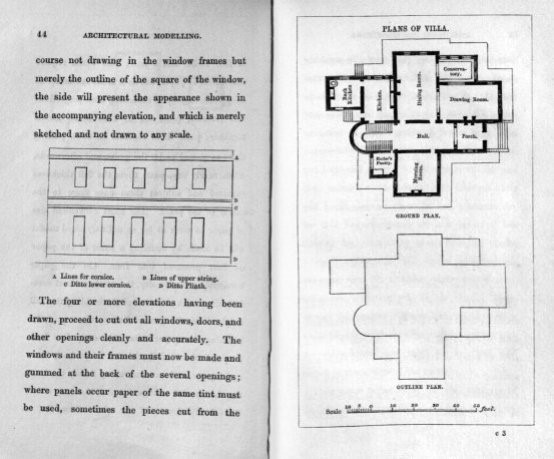Dr Matthew Wells
Echoing the import of anatomical models from Italy, France and Germany to Britain in the early nineteenth century, in 1827 Bernhard Heinrich Blasche’s The Art of Working in Pasteboard was translated from German for a British audience. Although model-making handbooks had a longer history in continental Europe, Blasche’s book was the first study in English that could provide readers with the theoretical and practical principles in the ‘art’ of model-making. Once a reader had mastered the ability to model a pyramid, a cone, and a ball, the book provided a general outline of how to make models of ornaments, objects, and buildings from pasteboard: a stiff but pliable material made by pasting three or more sheets of paper together and compressing them. Blasche advised that wire clamps, chisels, and knives, the sort that could be procured from bookbinders or shoemakers, would be required by his readers in order to work the raw material into models.

Whilst there would surely have been a general readership for Blasche’s work, judging by reviews in the architectural and building press the primary audience for the handbook was formed from ‘pupils’. The pupillage system, where young men were attached to an architect’s office as assistants for a multi-year period, was the predominant method of architectural education until the early twentieth century.

Despite the emergence of supplementary courses at the University of London and the Architectural Association in the 1840s, there was a lack of formalised model-making in architectural education throughout the nineteenth century. However, a handbook published in 1859 by the Chester-based architect T. A. Richardson supplemented the body of knowledge available on the subject. In The Art of Architectural Modelling in PaperRichardson proposed that the principle audience for his book was architectural assistants who in preparation for professional practice required practical knowledge of model making. In particular Richardson noted that models were becoming more widespread in open or limited competitions for buildings, which was one of the defining features of the Victorian architectural scene. This factor had consequences for architects: the short time-frames for buildings to be designed inherent to the competition system increased the importance of producing models quickly and efficiently. Additionally, Richardson believed that the instruction offered in his book had the potential to provide the architect with clarity when communicating with clients, who he claimed could not correctly understand either perspective or orthographic drawings. In order to support a reader’s practical knowledge of the subject, Richardson analysed and described the materials, tools, and methods that could be used to make models. Moreover, Richardson described how models should be presented on baseboards and stands, and how ornamental details, materials and the surrounding landscape could be represented in miniature.
Several contemporary architectural journals positively reviewed Richardson’s book and a second edition was published in 1887. Similarly, Blache’s work was republished in multiple editions across the nineteenth century. In addition to their value to the education of young architects, the publication of each of these handbooks demonstrates the character of model-making in the period.
Whilst Blasche focused on general skills and geometric forms before moving onto architectural models, Richardson offered practical advice about how to make and use models for an audience who were otherwise learning through first-hand experience in an architect’s office. Alongside examining the transmission of knowledge provided by the handbooks, the study of each handbook offers us a new understanding of the role of models in architectural practice, the materials, tools, and techniques required to make models, and the conceptual understanding that models can offer as three-dimensional representations in miniature.